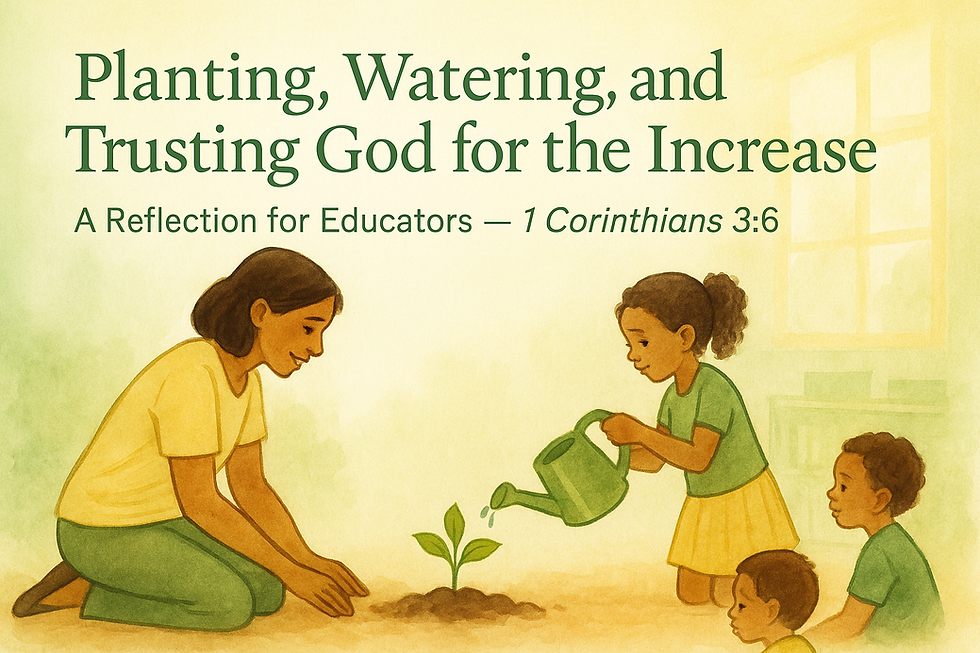Rewriting the Story: Making Outdoor Play Count in Early Childhood Development with Auntie Nats
- Natasha Francis-Campbell
- Sep 15
- 3 min read

Recent national assessments have revealed that over 40 percent of our nation’s four-year-olds are falling below the radar in key developmental milestones. This statistic should not discourage us. It should ignite us. As early childhood practitioners, we have the privilege and responsibility to rewrite the story for this new school year. With intentionality, planning, and creativity, outdoor play can become one of our most powerful tools to close developmental gaps and set our children on a path to success.
Why Outdoor Play Matters
Outdoor play is not just about “burning off energy.” It is a fertile ground for building gross motor skills, social interaction, problem-solving, emotional regulation, and confidence. Milestones such as catching and throwing a ball, skipping, standing on one leg, and climbing are directly linked to healthy brain and body development. When we design purposeful outdoor sessions, we provide children with opportunities to strengthen their muscles, refine their coordination, and boost their self-esteem.
Making Outdoor Sessions Meaningful
1. Plan with Milestones in Mind
Each outdoor activity should be designed to target a specific developmental goal. For example:
Catching and throwing balls – builds hand-eye coordination and teamwork.
Skipping with a rope – improves balance, rhythm, and cardiovascular endurance.
Standing on one leg – strengthens core muscles and supports concentration.
Climbing (jungle gyms, ladders, or slopes) – develops strength, confidence, and problem-solving.
Instead of free play alone, structure the time with milestone-focused activities while still leaving space for exploration.
2. Create Themed Stations
Organise the playground into activity stations:
Ball Zone – children practise rolling, passing, and tossing balls of different sizes.
Balance Zone – use stepping stones, balance beams, or chalk lines for walking, hopping, and standing still.
Movement Zone – ropes for skipping, hoops for jumping in and out, and cones for zigzag running.
Climbing Zone – supervised use of jungle gyms or improvised climbing frames.
Children can rotate between stations, ensuring each child experiences varied skills during the session.
3. Incorporate Storytelling and Role Play
Turn activities into imaginative adventures. For instance:
Imagine the balance beam as a bridge over a river filled with crocodiles.
Throwing balls becomes “feeding the hungry lions.”
Skipping ropes turn into “jumping over the river.”
When children are immersed in stories, they are more motivated to try new movements and persist for longer periods.
4. Encourage Peer Support
Outdoor play is an opportunity to foster social-emotional growth. Pair children up to cheer each other on, count jumps together, or roll a ball back and forth. These moments teach cooperation, patience, and encouragement.
5. Measure Progress and Celebrate Wins
Keep simple checklists of milestones:
Who can catch a medium-sized ball three times in a row?
Who can balance on one leg for 10 seconds?
Who has mastered skipping?
Use progress to adjust planning, and celebrate with the children when they accomplish new skills. These celebrations build motivation and resilience.
The Role of the Practitioner
Practitioners must see outdoor play not as “extra time” but as an intentional teaching space. Be actively engaged: model movements, cheer for effort, and scaffold skills for children who are struggling. Remember, every structured minute outside is an investment in literacy, numeracy, and life readiness, because physical milestones underpin the ability to sit, focus, write, and learn in the classroom.
A New School Year, A New Opportunity
This school year presents an opportunity to change the narrative. By planning carefully and leading outdoor play with purpose, we can ensure that no child remains below the radar. Outdoor play is not a break from learning; it is learning. With balls, ropes, beams, and imagination, we can nurture stronger, more confident children who are ready to thrive.



Comments